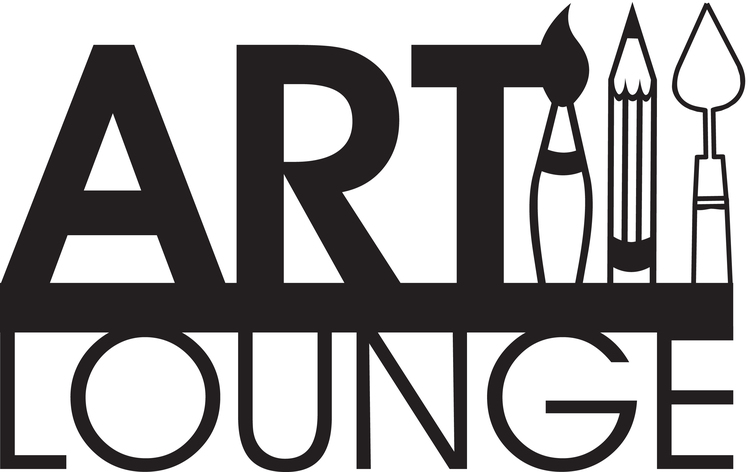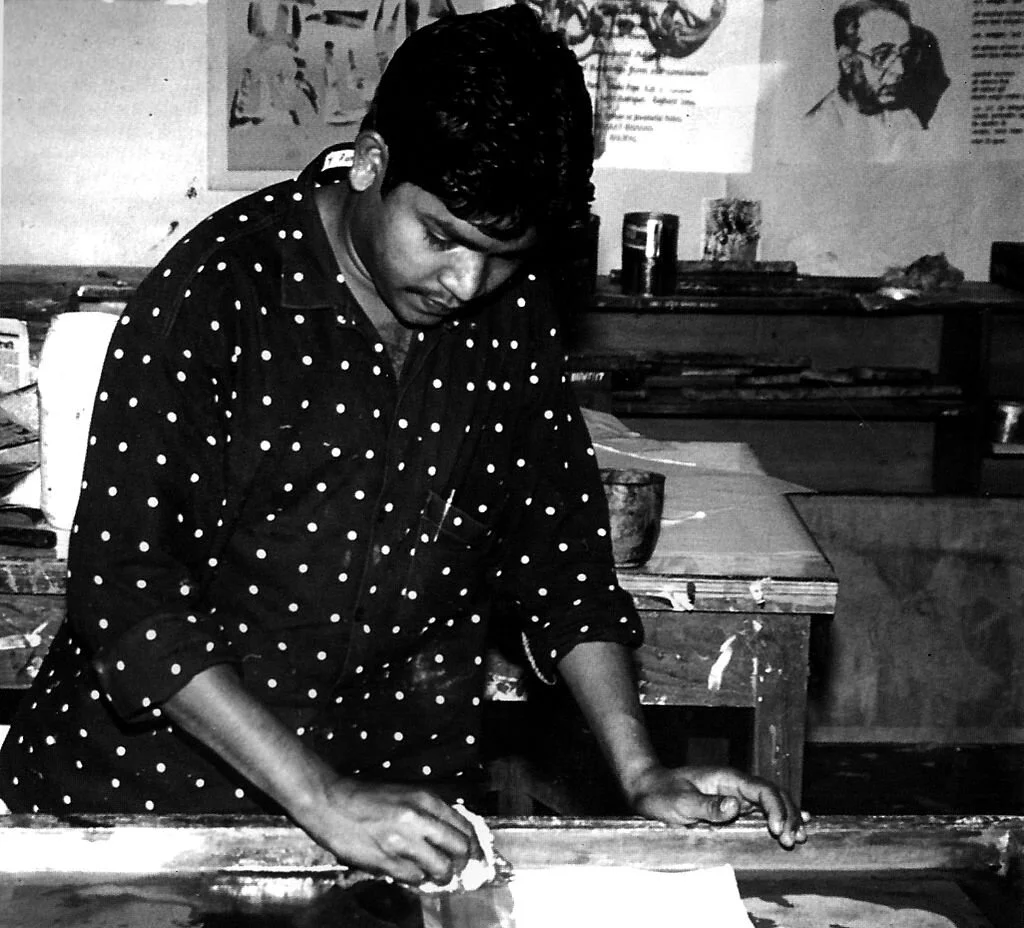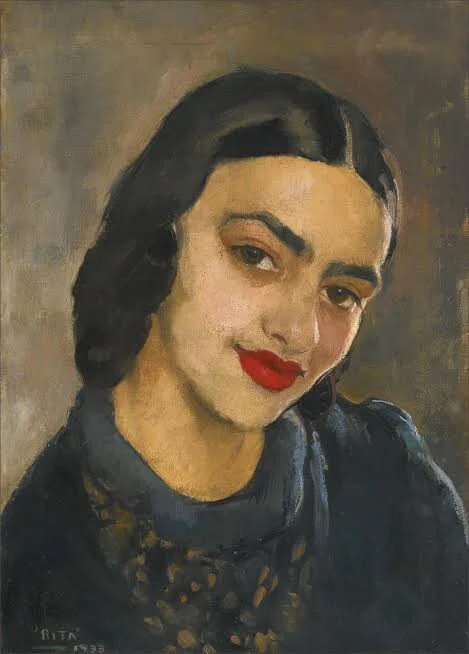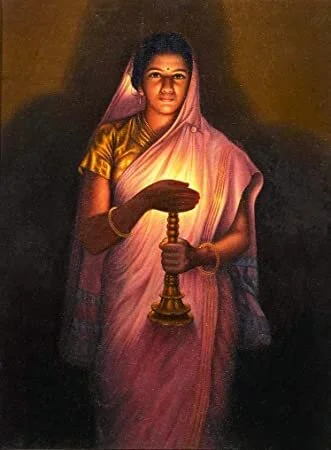Thomas William Roberts was an English-born Australian artist and a key member of the Heidelberg School art movement, also known as Australian impressionism. Roberts migrated with his family to Australia in 1869 to live with relatives. Settling in Collingwood, a suburb of Melbourne, Victoria.
Read MoreNatalia Sergeevna Goncharova was a Russian avant-garde artist, painter, costume designer, writer, illustrator, and set designer. She was a founding member of the Jack of Diamonds (1909–1911) and Donkey's Tail (1912–1913), and with Larionov invented Rayonism (1912–1914).
Read MoreKrishnaji Howlaji Ara was an Indian painter and is seen as the first contemporary Indian painter to meticulously use the female nude as a subject. He was a part of the Progressive Artists' Group in Bombay and was a founder of the Artists' Centre in Mumbai. Opinions about Ara's works remain divided with his critics accusing them of lacking perfection and not referenced from life.
Read MorePakhal Tirumal Reddy known as P T Reddy, was an Indian artist. He was the fifth child born to Ram Reddy and Ramanammachild at Annaram village, Karimnagar district, Telangana, India. He received his diploma in painting from J. J. School of Art, Bombay in 1939. He married Yashoda Reddy on 9 May 1947, and she completed a master's of art and Ph.D. degrees and authored over 22 compilations and novels. P T Reddy played a role in the introduction and the evolution of the so-called "Modern Art" of Europe to India.
Read MoreRamkinkar Baij was an Indian sculptor and painter, one of the pioneers of modern Indian sculpture and a key figure of Contextual Modernism. Baij was born in an economically modest family in the Bankura district of the modern state of West Bengal in India.
Read MoreManishi Dey was an Indian painter of the Bengal School of Art. He was born in Dhaka, Bengal Presidency on 22nd September, 1909. He died in Kolkata at the height of his career at 56 years of age. Manishi Dey was the younger brother of Mukul Dey, a pioneering Indian artist and dry point etcher. Their two sisters, Annapura and Rani, were accomplished in arts and crafts as well.
Read MoreGanga Devi was an Indian painter, considered by many as one of the leading exponents of Madhubani painting tradition. She is credited with popularizing the Madhubani painting outside India. She was born in 1928 in Mithila in the Indian state of Bihar in a Kayastha family and took to the traditional painting craft, specialising in the kachni (line drawing) style. She traveled abroad with her art and was a part of the Festival of India in the United States, which yielded a number of paintings under the title, America series, including Moscow Hotel, Festival of American Folk Life, and Ride in a Roller Coaster.
Read MoreR K Joshi was born in 1936, in Kolhapur, India. He was an academic type designer and calligrapher. He designed the core Indian fonts used in Microsoft Windows. He was brought up in the town of Kolhapur, Maharashtra. He developed an interest in alphabets, their shapes, styles and design. In 1952, he decided to study art at Sir J.J. Institute of Applied Art, Mumbai. During this time, he found a scarcity of typefaces in Indian languages.
Read MoreJangarh Singh Shyam (1962–2001) was a pioneering contemporary Indian artist. Jangarh was born into a Pardhan Gond family in the village of Patangarh, Eastern Madhya Pradesh. He grew up in extreme poverty which forced him to quit school and try his hand at farming. He grazed buffaloes and sold milk in a nearby town. Jangarh was approached by the talent scouts of the arts museum Bharat Bhavan, he met the artist Jagdish Swaminathan which led to a lifelong collaboration between the two.
Read MoreKatsushika Hokusai known simply as Hokusai, was a Japanese artist, ukiyo-e painter and printmaker of the Edo period. Born in Tokyo, Hokusai is best known as author of the woodblock print series Thirty-six Views of Mount Fuji which includes the internationally iconic print, The Great Wave off Kanagawa.
Read MoreRalph Hotere was born on 11 August 1931 in Mitimiti, Northland. He was a New Zealand artist and is widely regarded as one of New Zealand's most important artists. In 1994 he was awarded an honorary doctorate from the University of Otago and in 2003 received an Icon Award from the Arts Foundation of New Zealand. Hotere received his secondary education at Hato Petera College, Auckland, where he studied from 1946 to 1949.
Read MoreVasant Raghunath Amberkar was born in 1907 in Mumbai. From 1933-1939 he studied under S. L. Haldankar at S. L. Haldankar's Institute. He completed four years Ar training correspondence course of Press Art School under Percy V. Bradshaw.
Read MoreGaganendranath Tagore was an Indian painter and cartoonist of the Bengal school. Along with his brother Abanindranath Tagore, he was counted as one of the earliest modern artists in India.
Read MoreChéri Samba was born on 30 December 1956 is a painter from the Democratic Republic of Congo. He is one of the best known contemporary African artists, with his works being included in the collections of the Centre Georges Pompidou in Paris and the Museum of Modern Art in New York.
Read MoreMahadev Vishwanath Dhurandhar was born on 18 March 1867. He was noted Indian painter from the British colonial era. and postcard artist. His illustrations of women of that era doing their daily chores are especially popular.
Read MoreÉric Joisel was a French origami artist who specialized in the wet-folding method. He created figurative art sculptures using sheets of paper and water, without the use of any adhesive or scissors. Origami is derived from the Japanese words “ori” meaning “fold” and “kami” meaning paper. Origami is the Japanese art of forming sculptures out of paper only. And Eric Joisel took this to a whole new level.
Read MoreGerard Sekoto born in 9 December 1913. He was a South African artist and musician. He was the son of Andreas Sekoto, a leading member of the new Christian converts. He is recognised as the pioneer of urban black art and social realism.
Read MoreAmrita Sher-Gil was born on 30 January 1913. She was a Hungarian-Indian painter. She has been called "one of the greatest avant-garde women artists of the early 20th century" and a "pioneer" in modern Indian art. Drawn to painting from an early age, Sher-Gil started getting formal lessons in the art, at the age of eight. She first gained recognition at the age of 19, for her oil painting titled Young Girls (1932).
Read MoreSawlaram Lakshman Haldankar also know as S L Haldankar was a well-known Indian painter. Haldankar was born into a family from Sawantwadi, which was then a Princely State and is located today in Maharashtra state.
Read More





















